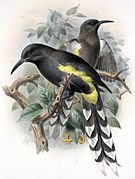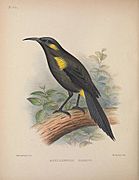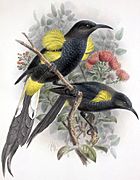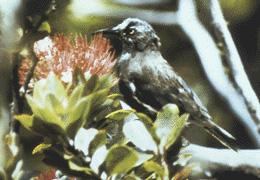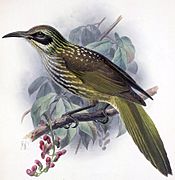Hawaiian honeyeaters facts for kids
Quick facts for kids Hawaiian honeyeatersTemporal range: Holocene
|
|
|---|---|
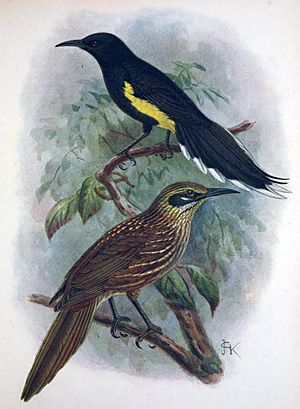 |
|
| Moho apicalis and Chaetoptila angustipluma | |
| Scientific classification |
|
| Kingdom: | Animalia |
| Phylum: | Chordata |
| Class: | Aves |
| Order: | Passeriformes |
| Family: | †Mohoidae Fleischer, James and Olson, 2008 |
| Genera | |
Mohoidae is the name of a special family of birds from Hawaii. These birds, called ʻōʻō (from the genus Moho) and kioea (from the genus Chaetoptila), are all sadly extinct. They used to drink nectar from flowers, just like hummingbirds do.
For a long time, scientists thought these Hawaiian birds were related to honeyeaters from places like Australia. This was because they looked very similar and acted alike. They even had similar body shapes.
But in 2008, scientists did a new study. They looked at the DNA from old bird specimens kept in museums. This study showed something surprising! The ʻōʻō and kioea birds were not actually related to honeyeaters at all. Instead, they were more closely related to birds like waxwings and silky-flycatchers. This means that the Hawaiian ʻōʻō and kioea birds did not evolve from Australian honeyeaters. They just ended up looking similar because they lived in similar ways. This is called convergent evolution. Because of these new findings, scientists created a new family, Mohoidae, just for these two extinct groups of birds.
Types of Mohoidae Birds
The Mohoidae family includes two main groups, or genera, of birds:
The Kioea
The genus Chaetoptila includes the kioea bird.
- Chaetoptila angustipluma (Kioea) - This was the main type of kioea.
- Chaetoptila cf.angustipluma (Oahu kioea) - This bird lived on the island of Oahu and became extinct even before Europeans arrived in Hawaii.
- ?Chaetoptila sp. (Narrow-billed kioea) - Another type of kioea that also became extinct before European contact.
The ʻŌʻō Birds
The genus Moho includes four types of ʻōʻō birds, all of which are now extinct.
- Moho apicalis – The Oʻahu ʻōʻō lived on the island of Oahu.
- Moho bishopi – Bishop's ʻōʻō was found on the island of Molokai.
- Moho braccatus – The Kauaʻi ʻōʻō lived on the island of Kauaʻi.
- Moho nobilis – The Hawaiʻi ʻōʻō was found on the island of Hawaiʻi.
Gallery
See also
 In Spanish: Mohoidae para niños
In Spanish: Mohoidae para niños


